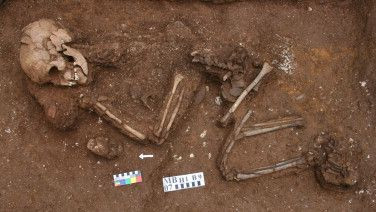Ancient Bones Show That Caring for the Disabled Is as Old as Society Itself

At a site known as Man Bac, archaeologists discovered 15 or so bodies. Most were buried with their bodies straight, with the exception of Burial 9 that was buried in the fetal position. Subsequent research indicated that the man was buried as he lived, as his fused vertebrae and brittle bones left him hunched over by his disease. Researchers eventually came to the conclusion that his form was the result of a congenital disorder called Klippel-Feil syndrome, which paralyzed him from the waist down, mostly robbed him of use of his arms, and would have meant that he would have been unable to feed and clothe himself.
However, he lived 10 years after the onset of his paralysis. That meant that his community, which lived by fishing, hunting, and raising pigs, would have catered to his every need, rallying him to give him some semblance of comfort.
While violence seems to be as old as humanity itself, so too does kindness and compassion. While evidence suggests that human hands, for example, evolved to throw punches, other studies show that it is in our genetic nature to stand up to bullies. Indeed, a growing pool of archaeologists are finding evidence that, even in ancient times, humans have banded together in order to take care of severely ailing and disabled people, many of whom were unable to take care of themselves.
Indeed, though Burial 9 may be the most drastic example found by archaeologists so far, there are others. One Neanderthal was found with one arm amputated, vision loss in one eye, and other injuries - but he lived to the age of 50. Another boy found in Florida who lived 7,500 years ago, lived to the age of 15 with spina bifida. Yet another skeleton was found belonging to a teenage boy whose severe dwarfism and short arms meant that his needs would have needed to be accommodated in order to survive in his hunting-and-gathering society.
Lorna Tilley, whose interest lies in ancient health care, says that archaeologists perform a four-step process to ascertain the society and its response to disabled people within it. First, they determine what is wrong. Then, they describe the level of impact that the person's disability would have on their culture, and what kind of care would have been needed. For example, Burial 9 would have required "direct support" like nursing care, while the teenager with dwarfism would need some assistance and tolerance of his limitations. The fourth step is to gather evidence of exactly how the people lived.
In the case of some individuals in ancient cultures, the society may have been too kind. One skeleton from 4,000 years ago indicated that the person had a musculoskeletal disease like polio. But one of her problems was not a result of the disease - cavities and abscesses in her teeth. Dr. Debra Martin said to the New York Times that her people, who grew dates, likely fed her the sticky sweets to keep her happy at the expense of her teeth. Her teeth rotted, unusual for someone so young.
Published by Medicaldaily.com



























